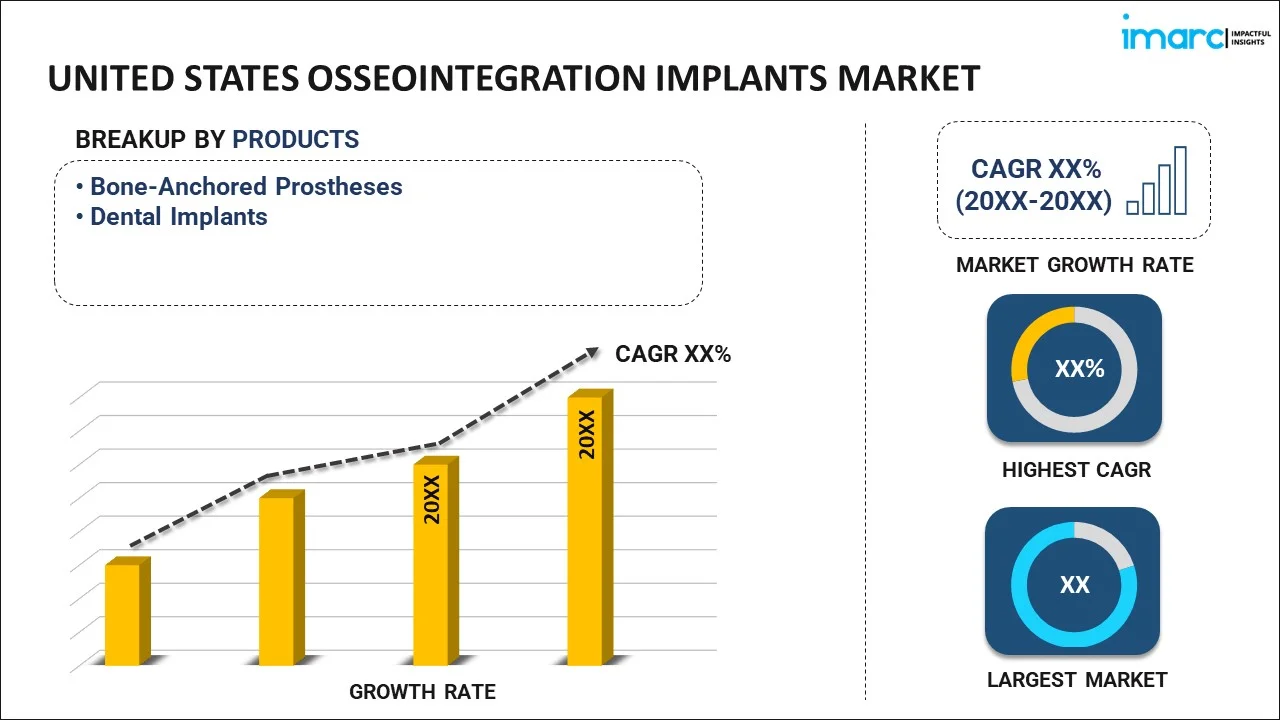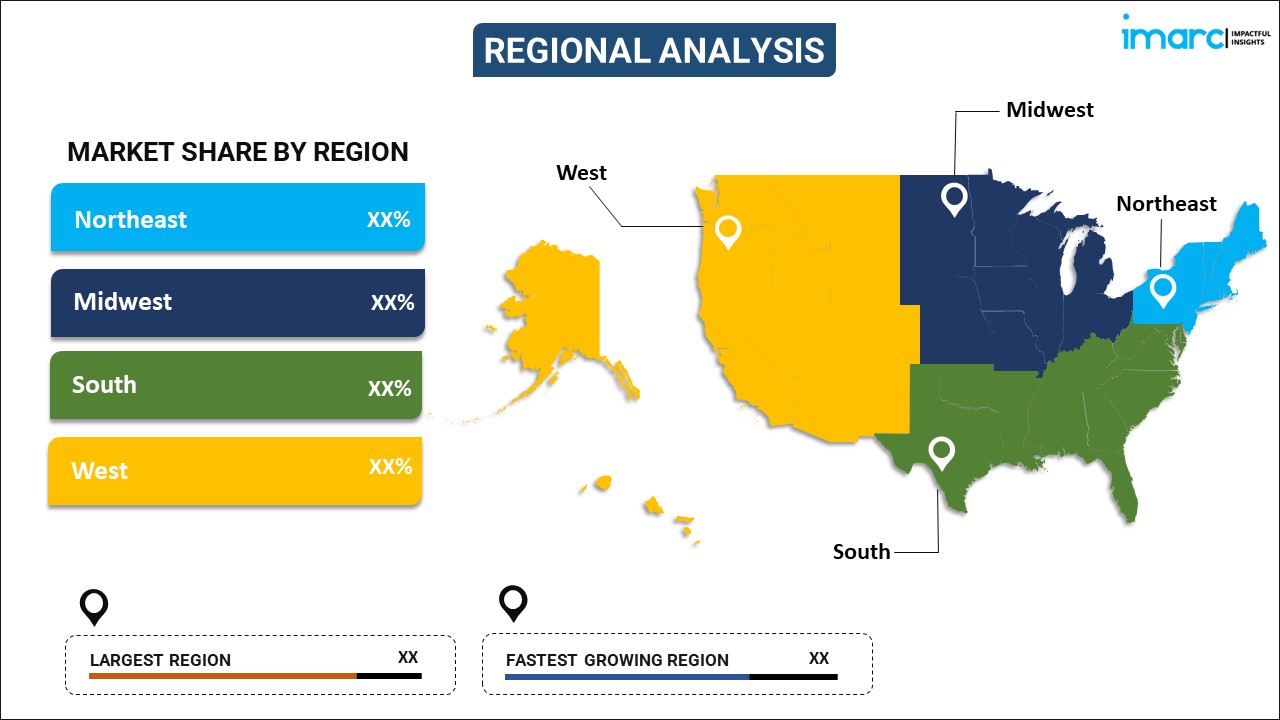
United States Osseointegration Implants Market Report by Product (Bone-Anchored Prostheses, Dental Implants), Material (Metallic, Ceramic, Polymeric, Biomaterials), End User (Hospitals, Ambulatory Surgical Centers, Dental Clinics), and Region 2025-2033
Market Overview:
United States osseointegration implants market size reached USD 1.7 Million in 2024. Looking forward, IMARC Group expects the market to reach USD 3.4 Million by 2033, exhibiting a growth rate (CAGR) of 8.4% during 2025-2033. The rising number of individuals suffering from osteoarthritis and extensive R&D activities represent some of the key factors driving the market.
|
Report Attribute
|
Key Statistics
|
|---|---|
|
Base Year
|
2024 |
|
Forecast Years
|
2025-2033
|
|
Historical Years
|
2019-2024
|
| Market Size in 2024 | USD 1.7 Million |
| Market Forecast in 2033 | USD 3.4 Million |
| Market Growth Rate (2025-2033) | 8.4% |
Osseointegration implants are a category of endosteal implants characterized by the presence of pores that facilitate the migration of osteoblasts and supporting connective tissues. They are crafted using materials, such as ceramics, biostable polymers, and metals like titanium, chromium, tantalum, cobalt, and stainless steel. They establish a direct structural connection between the bone and the implant, eliminating the need for interposed connective tissues, and promoting the ingrowth or interdigitation of newly formed lamellar bone. Notably, osseointegration implants present advantages over traditional procedures, including fewer side effects, increased stability, and a reduced recovery period post-surgery. This has led to their widespread utilization in various applications, such as dental implants, bone-anchored hearing aids, endoprostheses, spinal instrumentation hardware, and knee and joint replacement, highlighting their versatility in diverse medical contexts.
United States Osseointegration Implants Market Trends:
The United States osseointegration implants market is witnessing substantial growth, driven by the increasing adoption of these advanced endosteal implants across a spectrum of medical applications. Additionally, a distinctive feature of osseointegration implants is their ability to establish a direct structural connection between the bone and the implant, promoting the ingrowth of newly formed lamellar bone without interposed connective tissues, which is acting as another significant growth-inducing factor. Besides this, compared to traditional procedures, osseointegration implants offer advantages, such as enhanced stability, fewer side effects, and reduced post-surgery recovery times, thereby positively influencing the regional market. The versatility of osseointegration implants is evident in their widespread usage across diverse medical fields in the United States. From dental implants to bone-anchored hearing aids, endoprostheses, spinal instrumentation hardware, and knee and joint replacements, these implants play a crucial role in improving patient outcomes and quality of life. As technological advancements in implant materials and design continue, the United States osseointegration implants market is poised for sustained growth, reflecting a paradigm shift in orthopedic and dental procedures towards more effective and patient-friendly solutions over the forecasted period.
United States Osseointegration Implants Market Segmentation:
IMARC Group provides an analysis of the key trends in each segment of the market, along with forecasts at the country level for 2025-2033. Our report has categorized the market based on product, material, and end user.
Product Insights:

- Bone-Anchored Prostheses
- Dental Implants
The report has provided a detailed breakup and analysis of the market based on the product. This includes bone-anchored prostheses and dental implants.
Material Insights:
- Metallic
- Ceramic
- Polymeric
- Biomaterials
A detailed breakup and analysis of the market based on the material have also been provided in the report. This includes metallic, ceramic, polymeric, and biomaterials.
End User Insights:
- Hospitals
- Ambulatory Surgical Centers
- Dental Clinics
The report has provided a detailed breakup and analysis of the market based on the end user. This includes hospitals, ambulatory surgical centers, and dental clinics.
Regional Insights:

- Northeast
- Midwest
- South
- West
The report has also provided a comprehensive analysis of all the major regional markets, which include the Northeast, Midwest, South, and West.
Competitive Landscape:
The market research report has also provided a comprehensive analysis of the competitive landscape in the market. Competitive analysis such as market structure, key player positioning, top winning strategies, competitive dashboard, and company evaluation quadrant has been covered in the report. Also, detailed profiles of all major companies have been provided.
United States Osseointegration Implants Market Report Coverage:
| Report Features | Details |
|---|---|
| Base Year of the Analysis | 2024 |
| Historical Period | 2019-2024 |
| Forecast Period | 2025-2033 |
| Units | Million USD |
| Scope of the Report | Exploration of Historical Trends and Market Outlook, Industry Catalysts and Challenges, Segment-Wise Historical and Future Market Assessment:
|
| Products Covered | Bone-Anchored Prostheses, Dental Implants |
| Materials Covered | Metallic, Ceramic, Polymeric, Biomaterials |
| End Users Covered | Hospitals, Ambulatory Surgical Centers, Dental Clinics |
| Regions Covered | Northeast, Midwest, South, West |
| Customization Scope | 10% Free Customization |
| Post-Sale Analyst Support | 10-12 Weeks |
| Delivery Format | PDF and Excel through Email (We can also provide the editable version of the report in PPT/Word format on special request) |
Key Questions Answered in This Report:
- How has the United States osseointegration implants market performed so far and how will it perform in the coming years?
- What has been the impact of COVID-19 on the United States osseointegration implants market?
- What is the breakup of the United States osseointegration implants market on the basis of product?
- What is the breakup of the United States osseointegration implants market on the basis of material?
- What is the breakup of the United States osseointegration implants market on the basis of end user?
- What are the various stages in the value chain of the United States osseointegration implants market?
- What are the key driving factors and challenges in the United States osseointegration implants?
- What is the structure of the United States osseointegration implants market and who are the key players?
- What is the degree of competition in the United States osseointegration implants market?
Key Benefits for Stakeholders:
- IMARC’s industry report offers a comprehensive quantitative analysis of various market segments, historical and current market trends, market forecasts, and dynamics of the United States osseointegration implants market from 2019-2033.
- The research report provides the latest information on the market drivers, challenges, and opportunities in the United States osseointegration implants market.
- Porter's five forces analysis assist stakeholders in assessing the impact of new entrants, competitive rivalry, supplier power, buyer power, and the threat of substitution. It helps stakeholders to analyze the level of competition within the United States osseointegration implants industry and its attractiveness.
- A competitive landscape allows stakeholders to understand their competitive environment and provides an insight into the current positions of key players in the market.
Need more help?
- Speak to our experienced analysts for insights on the current market scenarios.
- Include additional segments and countries to customize the report as per your requirement.
- Gain an unparalleled competitive advantage in your domain by understanding how to utilize the report and positively impacting your operations and revenue.
- For further assistance, please connect with our analysts.

 Inquire Before Buying
Inquire Before Buying
 Speak to an Analyst
Speak to an Analyst
 Request Brochure
Request Brochure
 Request Customization
Request Customization



.webp)




.webp)












